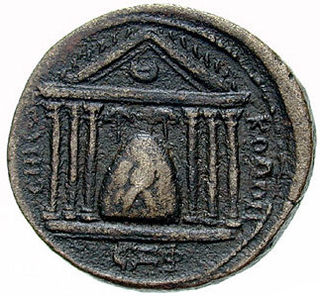 W
WBaetylus are sacred stones that were supposedly endowed with life. According to ancient sources, these objects of worship were meteorites, which were dedicated to the gods or revered as symbols of the gods themselves.
Batikam Stone is a historical heritage object in Jorong Dusun Tuo, Nagari Limo Kaum, Tanah Datar Regency, on Sumatra in Indonesia. Translated from Indonesian, Batu Batikam means the stone that getting stabbed.
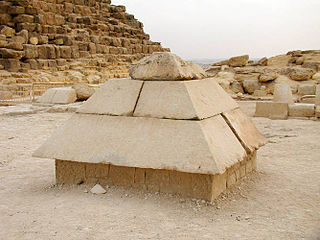 W
WIn the creation myth of the Heliopolitan form of ancient Egyptian religion, Benben was the mound that arose from the primordial waters Nu upon which the creator deity Atum settled. The Benben stone is the top stone of the pyramid. It is also related to the obelisk.
 W
WThe Black Stone is a rock set into the eastern corner of the Kaaba, the ancient building in the center of the Grand Mosque in Mecca, Saudi Arabia. It is revered by Muslims as an Islamic relic which, according to Muslim tradition, dates back to the time of Adam and Eve.
 W
WSin-Kamen is a type of pagan sacred stones, widespread in Russia in areas historically inhabited by both Eastern Slavic (Russian), and Volga Finnic tribes. Unlike Sledovik, Blue Stones did not have major hallows on them, and were venerated in a simpler way: by pouring water on them, or leaving food offerings. Some of the Blue Stones are still known, and to some extent venerated by local populations.
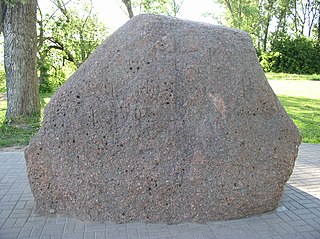 W
WBoris Stones, also called Dvina Stones, are seven medieval artifacts erected along the bank of the Western Dvina between Polotsk and Drissa, Belarus. They probably predate Christianity in the area, but were inscribed in the 12th century with text and an image of Christ. The largest of the stones is 17 metres in circumference.
 W
WA bullaun is the term used for the depression in a stone which is often water filled. Natural rounded boulders or pebbles may sit in the bullaun. The size of the bullaun is highly variable and these hemispherical cups hollowed out of a rock may come as singles or multiples with the same rock.
 W
WA cattle rubbing stone is a stone allowing cattle to rub their skin without causing damage to field infrastructure such as fences and posts, or natural features such as trees. They were once a common sight in pastures in Britain, but many have since been removed to accommodate the needs of modern farming practices. Cattle are depicted on Pictish stones such as the Fowlis Wester stone; however, the requirement for rubbing stones mainly relates to the enclosure of fields in the late 18th century that held cattle within a confined area.
 W
WThe Foundation Stone, or the Noble Rock is the rock at the centre of the Dome of the Rock in Jerusalem. It is also known as the Pierced Stone because it has a small hole on the southeastern corner that enters a cavern beneath the rock, known as the Well of Souls.
 W
WGolosov Ravine, also known as Vlasov (Власов) ravine is a deep ravine in Moscow, Russia, between the Kolomenskoe Hill and Dyakovo Hill. The ravine has several springs and a brook streaming at its bottom. Up in the ravine, on the left side of it, there is a Neopagan shrine, organized around two venerated "sacred stones". In years 2006–2007, during the renovation of Kolomenskoe sides of the ravine were reinforced, and pedestrian paths and stairs were created on its sides.
 W
WShingū is a city located in Wakayama Prefecture, Japan. The city was founded on October 1, 1933.
 W
WIndian God Rock is a large boulder in the northwestern part of the U.S. state of Pennsylvania. Located near the unincorporated community of Brandon, it lies along the Allegheny River in Venango County's Rockland Township. It is significant for the large petroglyph on one of its sides. Because of the petroglyph, the rock has been an explorers' landmark, a tourist attraction, and an object of scholarly investigation.
 W
WMani stones are stone plates, rocks and/or pebbles, carved or inscribed with the six syllabled mantra of Avalokiteshvara, as a form of prayer in Tibetan Buddhism. The term mani stone may also be used to refer to stones on which any mantra or devotional designs are inscribed or painted. Mani stones are intentionally placed along the roadsides and rivers or placed together to form mounds or cairns or sometimes long walls, as an offering to spirits of place or genius loci. Creating and carving mani stones as devotional or intentional process art is a traditional sadhana of piety to yidam. Mani stones are a form of devotional cintamani.
 W
WThe Maqām Ibrāhīm is a small square stone associated with Ibrahim (Abraham), Ismail (Ishmael) and their rebuilding of the Kaaba in what is now the Great Mosque of Mecca in the Hejazi region of Saudi Arabia. According to Islamic tradition, the imprint on the stone came from Ibrahim's feet.
 W
WA megalith is a large pre-historic stone that has been used to construct a structure or monument, either alone or together with other stones. There are over 35,000 in Europe alone, ranging from Sweden to the Mediterranean sea.
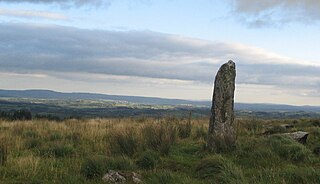 W
WA menhir, standing stone, orthostat, or lith is a large man-made upright stone, typically dating from the European middle Bronze Age. They can be found solely as monoliths, or as part of a group of similar stones. Menhirs' size can vary considerably, but they are generally uneven and squared, often tapering towards the top.
 W
WMeoto Iwa (夫婦岩), or the Married Couple Rocks, are two rocky stacks in the sea off Futami, Mie, Japan. They are joined by a shimenawa and are considered sacred by worshippers at the neighboring Futami Okitama Shrine. According to Shinto, the rocks represent the union of the creator of kami, Izanagi and Izanami. The rocks, therefore, celebrate the union in marriage of man and woman. The rope, which weighs over a ton, must be replaced several times a year in a special ceremony. The larger rock, said to be male, has a small torii at its peak.
 W
WThe Rock of Guatape, or simply La Piedra or El Peñol, is a landmark inselberg also known as The Stone of El Peñol, in Colombia. It is located in the town and municipality of Guatapé, Antioquia. The town of El Peñol, which borders Guatapé, has also historically claimed the rock as their own and thus has led to different names for the site.
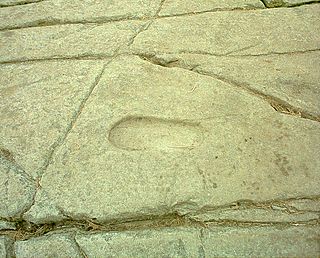 W
WA petrosomatoglyph is a supposed image of parts of a human or animal body in rock. They occur all over the world, often functioning as an important form of symbolism, used in religious and secular ceremonies, such as the crowning of kings. Some are regarded as artefacts linked to saints or culture heroes.
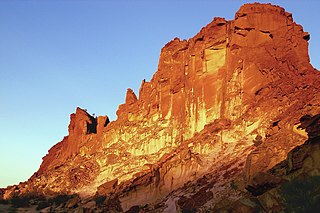 W
WRainbow Valley Conservation Reserve is a protected area located south of Alice Springs, Northern Territory in Australia. The reserve was established in 1990 to protect the unique sandstone formations and the Aboriginal art, artifacts and sacred natural objects within an area of 24.83 km2 (9.59 sq mi) around a large sandstone bluff. The sandstone layers in the main formation resemble the coloured stripes of a rainbow, with the red-orange hues of sandstone that is rich with iron creating a strong contrast with the lighter shaded sandstone that turns pale yellow or gold in the late day sun as it shines on the northwest-facing cliffs.
 W
WThe Sacred Rock of Hunza is carved rock as well as a cultural heritage site in Gilgit-Baltistan, Pakistan. The carvings on the rock dates back to the 1st Millennium AD. The rock is on a top of a hill which lies in east to the Hunza River. The site is on the main Karakoram Highway (KKH) in between Ganish village and Attabad Lake. The rock is divided into two parts, once there used to be some Buddhist shelter caves which fell over time. The rock is one of the major tourist attractions in Gilgit-Baltistan.
 W
WAccording to Latter Day Saint theology, seer stones were believed to have been used by Joseph Smith, as well as ancient prophets, to receive revelations from God. Members of The Church of Jesus Christ of Latter-day Saints believe that Smith used seer stones to translate the Book of Mormon.
 W
WSledovik is a most widespread type of sacred stones, venerated in Slavic and Finnic pagan practices. These are big stones, usually granite boulders of glacier origin, with hollows in them, that frequently bear traces of processing, and in some cases resemble foot traces, similar to those that might be left by a bare foot on a soft clay-like surface. It is not completely clear if the stones were selected for veneration because the hollows resembled foot traces, or whether the hollows were processed to resemble footprints; most probably both interpretations are at least partly applicable.
 W
WSugar Loaf is a 75-foot-high (23m) landlocked rock or stack in the interior of Mackinac Island in Lake Huron. Created by erosion during the period of postglacial Lake Algonquin, Sugar Loaf is the largest post-glacial erosion feature in the Straits of Mackinac.
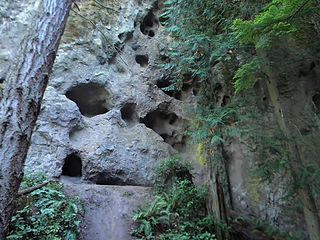 W
WTamanowas Rock, also called Chimacum Rock, is a 150-foot (46 m) high rock with caves and crevices that lies in a forest adjacent to Anderson Lake State Park, near Port Townsend, Washington. It is a sacred site to the Coast Salish peoples of the Pacific Northwest and a pilgrimage site. The rock was listed on the National Register of Historic Places in 2015.
 W
WThe Tower of Jericho is an 8.5-metre-tall (28 ft) stone structure, built in the Pre-Pottery Neolithic A period around 8000 BCE. It is among the earliest stone monuments of humanity.
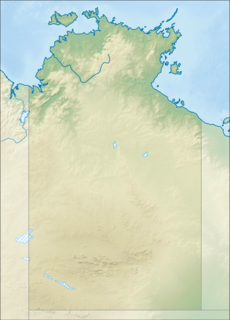 W
WUluru, also known as Ayers Rock and officially gazetted as Uluru / Ayers Rock, is a large sandstone rock formation in the southern part of the Northern Territory in central Australia. It lies 335 km (208 mi) south west of the nearest large town, Alice Springs.
 W
WIn the Latter Day Saint movement, the term Urim and Thummim (;) refers to a descriptive category of instruments used for receiving revelation or translating languages. According to Latter Day Saint theology, the two stones found in the breastplate of Aaron in the Old Testament, the white stone referenced in the Book of Revelation in the New Testament, the two stones bound by silver bows into a set of spectacles (interpreters) that movement founder Joseph Smith said he found buried in the hill Cumorah with the golden plates, and the seer stone found while digging a well used to translate the Book of Mormon are all examples of Urim and Thummim. Latter Day Saint scripture states that the place where God resides is a Urim and Thummim, and the earth itself will one day become sanctified and a Urim and Thummim, and that all adherents who are saved in the highest heaven will receive their own Urim and Thummim.
 W
WThe Willamette Meteorite, officially named Willamette and originally known as Tomanowos by the Clackamas Chinook Native American tribe is an iron-nickel meteorite found in the U.S. state of Oregon. It is the largest meteorite found in North America and the sixth largest in the world. There was no impact crater at the discovery site; researchers believe the meteorite landed in what is now Canada or Montana, and was transported as a glacial erratic to the Willamette Valley during the Missoula Floods at the end of the last Ice Age. It has long been held sacred by indigenous peoples of the Willamette Valley, including the federally recognized Confederated Tribes of the Grand Ronde Community of Oregon (CTGRC).